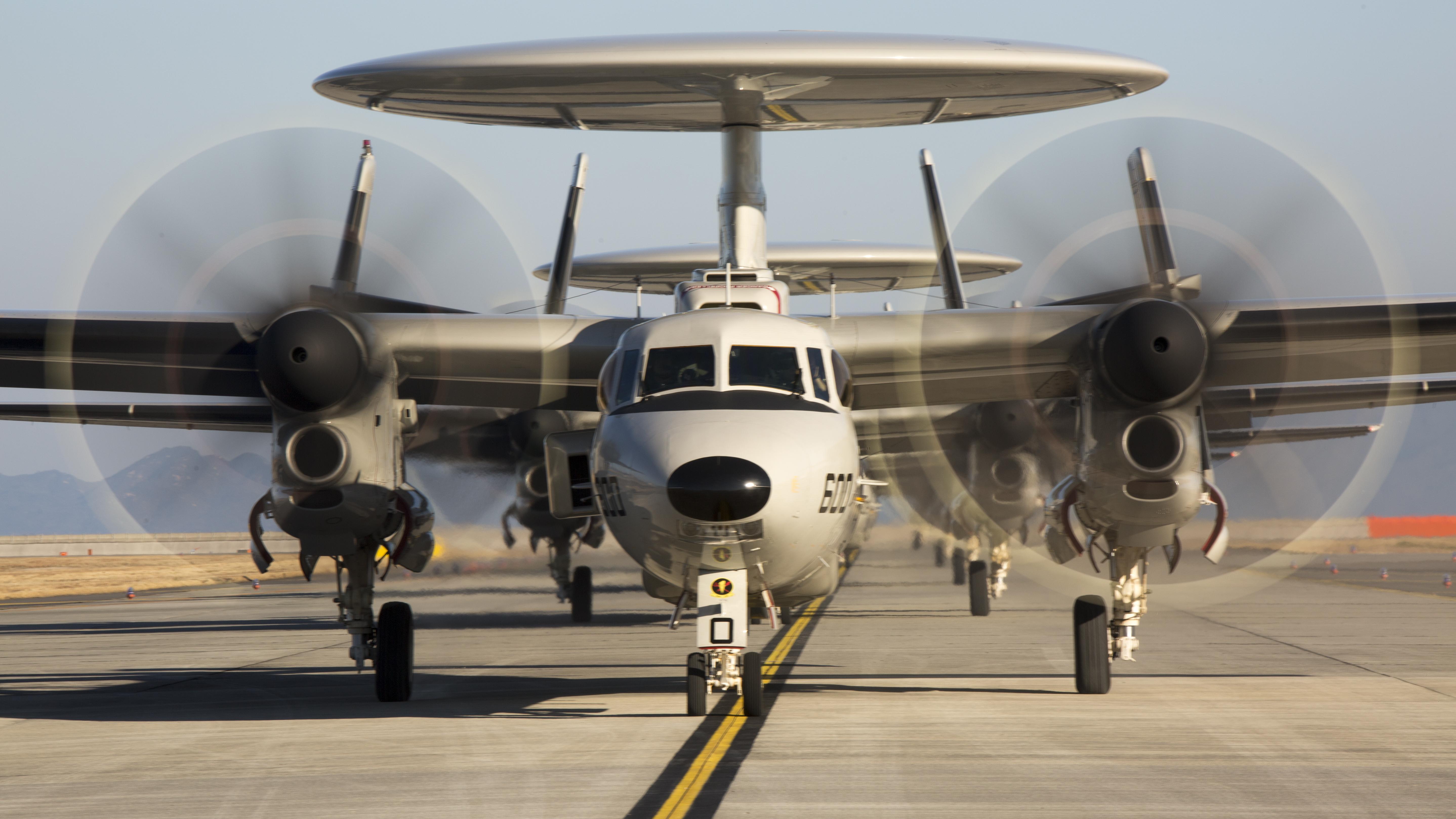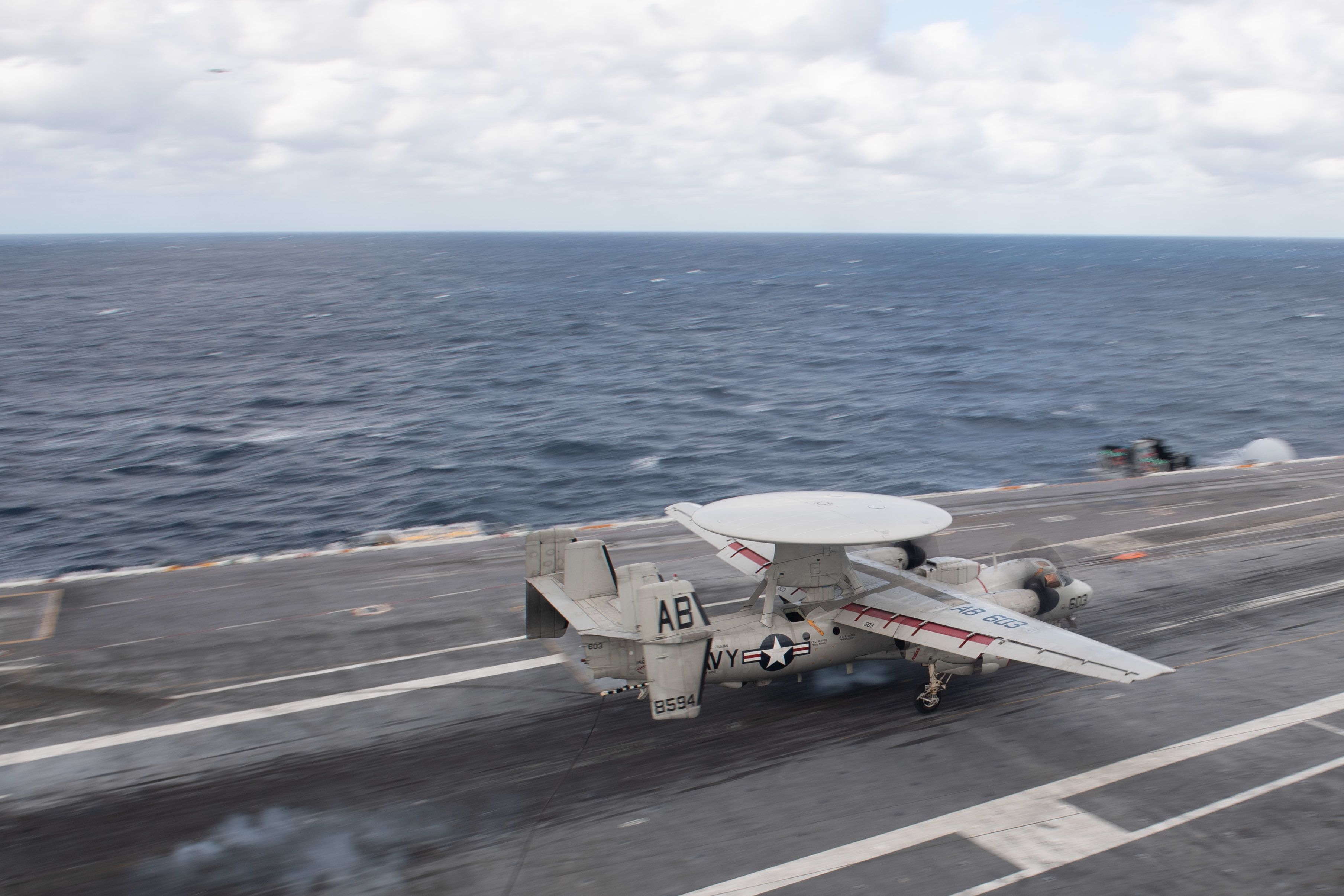E2c Hawkeye Aircraft - The Northrop Grumman E-2 Hawkeye is an American all-weather aircraft that can fly Tactical Airborne Early Warning (AEW). This twin-turboprop aircraft was designed and developed in the late 1950s and early 1960s by the Grumman Aircraft Company for the US Navy as a replacement for the earlier piston-powered E-1 Tracer, which was rapidly becoming obsolete. The aircraft's performance was improved with the E-2B and E-2C versions, with most changes made to radar and radio communications due to advances in integrated circuits and other electronics. The fourth major version of the Hawkeye is the E-2D, which first flew in 2007. The E-2 was the first aircraft designed specifically for its role, as opposed to a modification of an existing airframe such as the Boeing E-3 . Try. Variants of the Hawkeye have been in continuous production since the 1960s, giving it the longest production run of any carrier-based aircraft.
Because it replaced WF (later E-1) "Willy Fudd". In recent decades, the E-2 has often been referred to as the "Hummer" due to the distinctive sounds of its turboprop engines, quite different from the turbojet and turbofanjet engines. In addition to US Navy service, smaller numbers of E-2s have been sold to the armed forces of Egypt, France, Israel, Japan, Mexico, Singapore and Taiwan.
E2c Hawkeye Aircraft
This section needs more citations for confirmation. Help make this article better by adding citations to credible sources. Unsourced material may be questioned and removed. (January 2013) (Find out how and what to remove this template message)
Northrop Grumman E 2c Hawkeye Of Us Navy Stock Photo
Continued improvements in airborne radar through 1956 led to the construction of AEW aircraft by many different countries and many different militaries. The functions of command and control and maritime and air surveillance were also added. The first carrier-based aircraft to perform these missions for the US Navy and its allies was the Douglas AD Skyraider, which was replaced in US Navy service by the Grumman E-1 Tracer, which was a modified version of the S twin. -2 Tracker. - gyne anti-submarine warfare aircraft, where the radar was carried in an airfoil-shaped radome carried over the aircraft fuselage.
In 1956, the US Navy developed a requirement for an airborne warning aircraft whose data could be integrated into the Naval Tactical Data System aboard Navy ships, with a Grumman design selected to meet this requirement in March 1957.
The project, originally designated the W2F-1 but later redesignated the E-2A Hawkeye, was the first transport aircraft to be designed from the ground up as an AEW and command and control aircraft. Grumman's design engineers faced major challenges, including the requirement that the aircraft be able to operate from the formerly modified Essex-class aircraft carriers. Built during World War II, these ships were smaller than modern aircraft carriers and were later modified to allow jet aircraft to operate. Consequently, various height, weight, and length limitations had to be considered in the E-2A's design, resulting in some sub-optimal handling characteristics. However, the E-2A never operated on the modified Essex-class aircraft carriers.
The first prototype, which served only as an aerodynamic test bed, flew on October 21, 1960. The first fully equipped aircraft was launched on April 19, 1961 and entered service with the US Navy as the E-2A in January 1964.
Amazon.com: Hasegawa E 2c Hawkeye J.a.s.d.f. Limited Edition Model Kit
In 1965, the project accumulated so many development problems that it was canceled after 59 aircraft had already been built. In particular, there were difficulties due to insufficient cooling in the compacted avionics compartment. Early computers and complex avionics systems generated significant heat and could fail without adequate ventilation. These problems continued long after the aircraft entered service. At one point, reliability was so poor that the aircraft deck fleet was grounded.
After Navy officials were forced to explain to Congress why four production contracts were signed before aircraft technology testing was completed, action was taken; Grumman and the US Navy scrambled to improve the design. The unreliable rotary drum computer was replaced with a Litton L-304 digital computer
And several avionics systems were replaced - the upgraded aircraft were designated E-2Bs. In total, 49 of the 59 E-2As were upgraded to the E-2B standard. These aircraft replaced the E-1B Tracers in the US Navy's various AEW squadrons.

While the updated E-2B was a vast improvement over the unreliable E-2A, it was a temporary measure. The US Navy knew that the design had a much greater capacity and had not yet achieved the performance and reliability parameters set out in the original 1957 design. In April 1968, a reliability improvement program was initiated. Furthermore, now that the aircraft's capabilities were beginning to be realized, more was wanted; 28 new E-2Cs were ordered to augment the 49 E-2Bs to be upgraded. Improvements on new and upgraded aircraft were focused on radar and computer performance.
Hawkeye Bailout At 4,000 Feet
Two E-2A test machines were modified as E-2C prototypes, the first flying on 20 January 1971. Tests were satisfactory and the E-2C was ordered into production. The first production aircraft made its maiden flight on September 23, 1972. The original E-2C, known as Group 0, consisted of 55 aircraft; the first aircraft became operational in 1973 and served on aircraft carriers in the 1980s and 1990s until they were replaced in frontline service by aircraft from Group II. The US Navy Reserve used some aircraft to track drug dealers. The type was often used in conjunction with the Grumman F-14 Tomcat fighter; monitoring airspace and vectoring Tomcats on the Link-4A data link to destroy potential threats with long-range AIM-54C Phoix missiles.
The next production, between 1988 and 1991, saw 18 aircraft built to Group I standard. The Group I aircraft replaced the E-2's aging APS-125 radar and T56-A-425 turboprops with their successors, the APS-139 radar system and the T56-A-427 turboprops. The first Group I aircraft entered service in August 1981. Upgrading the Group 0 aircraft to Group I specifications was considered, but the costs were comparable to a new production aircraft, so upgrades were not performed. Aircraft in Group I were flown only by Atlantic Fleet squadrons. This version was followed within a few years by Group II, which had the improved APS-145 radar. A total of 50 Group II aircraft were delivered, of which 12 were modernized Group I aircraft. This new version entered service in June 1992 and served on the Pacific and Atlantic Fleet squadrons.
In 1997, the US Navy intended to equip all frontline squadrons, for a total of 75 Group II aircraft. Grumman merged with Northrop in 1994 and plans began for the Group II Plus, also known as the Group II/NAV upgrade. This retained the same Group II computer and radar while upgrading the pilot's avionics, such as replacing the mechanical inertial navigation (INS) system with a more reliable and accurate INS driven by laser ring gyro, installing multi-function display units (MFCDUs) (minor to Group II) and GPS integration into the weapons system. A Group II variant with upgrades to the mission computer and CIC workstations is known as the MCU/ACIS, these were produced in small numbers due to the production of the Hawkeye 2000 shortly after its introduction. All Group II aircraft have had their old 1960s computer processors replaced with a mission computer with the same functionality via modern computer technology, known as a GrIIM RePr (Group II Mission Computer Replacement Program, pronounced "grim reaper") ").
Another upgrade for Group II was the Hawkeye 2000, which featured the same APS-145 radar but featured an updated mission computer and Advanced Control Indicator Set (ACIS) (CIC) workstations and carries the new CEC ( cooperative gagemt) US Navy ) capability) data link system. It is also equipped with a higher capacity vapor cycle avionics cooling system. Beginning in 2007, a hardware and software upgrade package began to be added to existing Hawkeye 2000 aircraft. This upgrade allows for faster processing, dual-track file capability, and access to satellite information networks. The Hawkeye 2000 cockpits being upgraded include solid-state glass displays and a GPS tracking function.
Us Frcsw Completes Pmi 2 Procedure Of Final E 2c Hawkeye Aircraft
The remaining Hawkeye Group II NAV Upgrade aircraft received GPS approach but did not receive the solid-state glass displays.
In 2004, the E-2C's propeller system was changed; a new eight-blade propeller system called the NP2000 was developed by the Hamilton-Sundstrand company to replace the old four-blade design. Improvements included reduced vibration and better maintenance as a result of being able to remove the propeller blades individually instead of removing the deck support and hub.
The propeller blades are constructed of carbon fiber with steel tip inserts and de-icing boots at the blade root.

Once consideration was given to replacing it with "Common Support Aircraft", this concept was abandoned. The latest version of the E-2 is the E-2D Advanced Hawkeye, which features an all-new avionics suite, including the new AN/APY-9 radar, radio suite, mission computer, integrated satellite communications, flight control, T56- A-427A engines, glass cockpit and air filling.
Crash Of A Grumman E 2c Hawkeye In Wallops Island
Which adds electronic scanning to the mechanical rotation of the radar in the radome. The E-2D includes provisions for the co-pilot to act
E2c hawkeye crash, e2c hawkeye, hawkeye aircraft, amazon e2c, e2c hawkeye model, e2c hawkeye pictures, grumman e2c hawkeye, e2c visa, e2c hawkeye squadrons, e2c aircraft, e2c, hawkeye

0 Comments